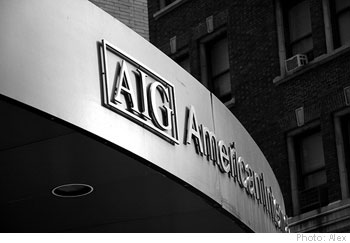 The Federal Reserve Bank of New York, then headed by current Treasury Secretary Tim Geithner, gave up much of its power during high-pressure negotiations with AIG’s (AIG) trading partners, caving to demands that they should be paid in full, the WSJ reports, citing a newly released government report.
The Federal Reserve Bank of New York, then headed by current Treasury Secretary Tim Geithner, gave up much of its power during high-pressure negotiations with AIG’s (AIG) trading partners, caving to demands that they should be paid in full, the WSJ reports, citing a newly released government report.
The new report, which was conducted by special inspector general for the Troubled Asset Relief Program, Neil Barofsky, explains how the New York Fed did not use its leverage as the regulator of some of these trading partners (banks) to get them to accept lower prices for more than $60 billion in credit-market bets. Instead, the New York Fed, notes the report, agreed that AIG’s creditors — whose bets were tied to souring mortgage-backed securities that had deteriorated in value — should be paid 100 cents on the dollar.
The banks that were paid off in full included Goldman Sachs (GS), Merrill Lynch, now BofA’s (BAC) unit, and large French banks Société Générale and Calyon, which were represented by the French bank regulator in negotiations with the New York Fed last November.
According the the report, only one bank – UBS AG (UBS)– said it was willing to accept a 2% haircut, or 98 cents on the dollar. But UBS’s good-faith gesture was quickly rejected by Goldman Sachs and the top French bank regulator. They refused the idea on the basis of it being improper and perhaps even criminal as such offer they said would force AIG’s trading partners to bear losses outside of bankruptcy court (the report said Geithner did not recall being told one bank was willing to take a haircut, but did not challenge the account of those on his staff.)
The Fed “refused to use its considerable leverage,” Barofsky wrote in its report. He said Secretary Geithner and the Fed’s lawyers had denied this, but “irrespective of their stated intent,” there was no doubt about the result: “Tens of billions of dollars of government money was funneled inexorably and directly to AIG’s counterparties.”
The Fed, in a letter that accompanied the report, said it “acted appropriately” in its dealings with AIG’s counterparties, and that its intervention in the insurer “was designed to prevent a system-wide collapse and achieved that end” by protecting the interests of AIG’s insurance policyholders and others.
The Fed argued it couldn’t use its leverage as a regulator because it was acting on behalf of AIG.
The giant insurer, after receiving several bailouts, holds government commitments worth up to $180 billion. The Treasury Department owns almost 80% of the company.
Disclaimer: This page contains affiliate links. If you choose to make a purchase after clicking a link, we may receive a commission at no additional cost to you. Thank you for your support!


Leave a Reply